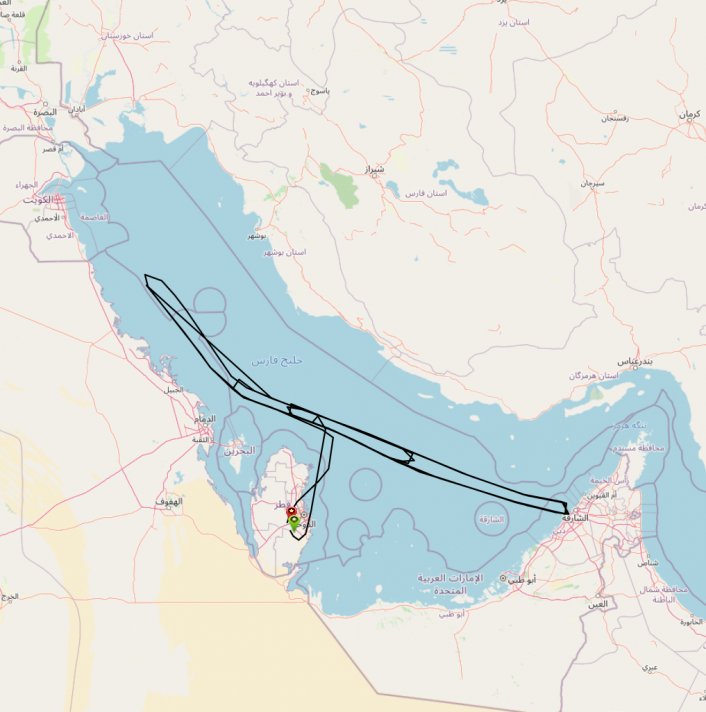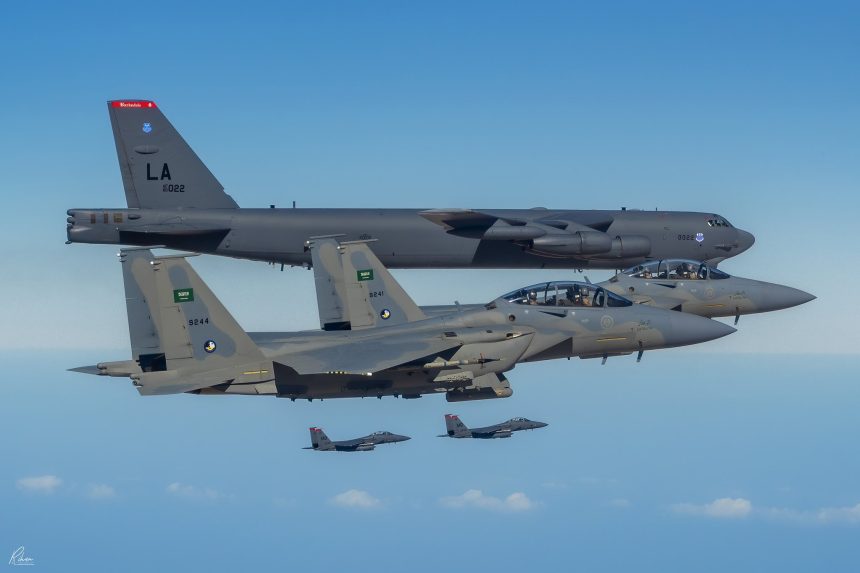Two U.S. Air Force B-52H bombers flew direct from Barksdale Air Force Base to the Persian Gulf during latest “deterrence mission” against Iran. And were escorted by Saudi F-15SA aircraft during the leg flown over Saudi Arabia.
On Dec. 9, two B-52s with the 2nd Bomb Wing at Barksdale AFB, Louisiana, launched for a 38-hour round trip mission to the Persian Gulf and Saudi Arabia. The short-notice, non-stop mission was “designed to underscore the U.S. military’s commitment to its regional partners, while also validating the ability to rapidly deploy combat power anywhere in the world”, said the senior commander of U.S. forces in the Middle East.
“The ability to fly strategic bombers halfway across the world in a non-stop mission, and to rapidly integrate them with multiple regional partners demonstrates our close working relationships and our shared commitment to regional security and stability,” said U.S. Central Command’s (CENTCOM) commander, Gen. Frank McKenzie, in a public release. In other words, the mission was a message of deterrence to Iran.
The one on Dec. 9, 2020 was the second mission in less than a month that B-52s flew directly to the Middle East from CONUS. On Nov. 21, B-52s belonging to the 5th Bomb Wing at Minot Air Force Base, North Dakota, flew a similar round-trip short-notice mission to the CENTCOM AOR where they integrated, with F-15Es and F-16s.
As already happened in the past, the pair of BUFFs could be tracked online during most of the their long-range trip from CONUS to the CENTCOM AOR (Area Of Responsibility) and several tankers supported the Global Power mission on Dec. 9 – 10.
Another B-52 power mission starting. This time from Barksdale to eastern Med area and back. Here SPUR72 RTB after refuelling B-52 COMAL11 Flt. Two B-52s to make the Atlantic crossing – route credit to @SBapati Pics #ADSB ex pic.twitter.com/3d9AhZqTgC
— Saint1 (@Saint1Mil) December 9, 2020
The portion of the mission flown over the Persian Gulf has probably attracted the interest of the Iranian air defense and for this reason a U.S. Air Force RC-135, using callsign PYTHON54 launched from Al Udeid, Qatar, and also flew up and down the Gulf as the B-52s operated there. Its mission was likely aimed to collect intelligence about the systems Iran switched on to monitor the U.S. bombers.

RC-135W PYTHON54 up over the Gulf with KC-135’s 58-0063, 61-0294 & 63-8019 in the air #potn pic.twitter.com/2CTuCXb5Qt
— Snoopy (@TheSnoopySnoop) December 10, 2020
The B-52s integrated with several assets during their mission. Among them, the Royal Saudi Air Force F-15SA of the 92nd Squadron.
#RSAF🇸🇦 F-15SA Advanced Eagles assigned to the 92nd Sqn escorted two #USAF🇺🇸 B-52 Stratofortress long-range bombers while crossing #SaudiArabia’s airspace on Dec. 10 pic.twitter.com/LlUHs9K3Pp
— محمد بن خالد (@MbKS15) December 11, 2020
The RSAF has just completed accepting the entire fleet of 84 SAs. Back in 2010, the RSAF requested 84 new-built F-15SA jets and upgrade package for 68 existing Saudi F-15S fighters for a total of 152 multirole advanced Eagles through a Foreign Military Sale: a contract worth 29.4 billion USD that included logistics, spares, maintenance support and weapons was eventually signed on Dec. 29, 2011.
These 92nd Sqn SAs are operated currently under the Air Warfare Center in Dhahran. Soon the 92nd SQN will be renewed with the new SA model instead of the Old S. A full SA Sqn (29th) has been already fielded in Tabuk and it is currently conducting aerial exercises with USAF F-16s from the 378th EW:
The 77th EFS and FGS visited and trained with RSAF at King Faisal Air Base. The visit bolstered partnership through inclusion and enhanced interoperability. Check out the partnership in action!#DoubleDown #WinToday #PrevailTomorrow@USAFCENT @CENTCOM @usaf
📸:SrA Leala Marquez pic.twitter.com/09vPHbNX4v
— 378 AEW (@378AEW) December 8, 2020
SAs units are mainly based now in Dhahran (King Abdulaziz AB), Tabuk (King Faisal AB) and Khamis Mushait (King Khalid AB). Soon new squadrons will be fielded in Al Kharj (Prince Sultan AB) and Al Jouf (Prince Naif AB), although the latter is still debatable as it can be moved to Hafr Al Baten (King Saud AB). The final decision will be subject to operational requirements: the RSAF might field a squadron anywhere and then send detachments, under the unit command, wherever needed.
#فيديو_الدفاع
المقاتلات السعودية ترافق القاذفات الأمريكية الإستراتيجية (بي-٥۲) أثناء عبورها أجواء #المملكة_العربية_السعودية. pic.twitter.com/NbHKIFMody
— وزارة الدفاع 🇸🇦 (@modgovksa) December 11, 2020
Equipped with the APG-63V3 Active Electronically Scanned Array (AESA) radar, a digital glass cockpit, JHMCS (Joint Helmet Mouted Cueing System), Digital Electronic Warfare System/Common Missile Warning System (DEWS/CMWS), IRST (Infra Red Search and Track) system, and able to carry a wide array of air-to-air and air-to-surface weaponry, including the AIM-120C7 AMRAAM (Advanced Medium Range Air-to-Air Missile) and the AIM-9X Sidewinder air-to-air missiles, the AGM-84 SLAM-ERs, the AGM-88 HARM (High-speed Anti-Radiation Missile) and the GBU-39 SDBs (Small Diameter Bombs) on 11 external hardpoints, the F-15SA, derived from the F-15E Strike Eagle, is the most advanced Eagle variant produced so far.
Hat tip to our friend @MbKS15 for providing us details about the current status of the Saudi F-15SA fleet.









